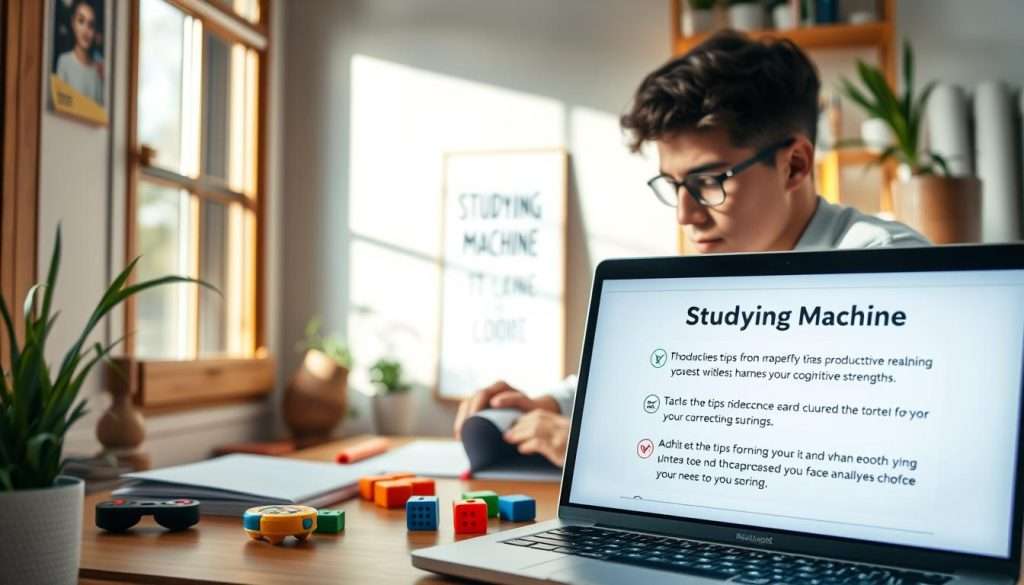Studying with ADHD can be tough. You might find your mind drifting off while trying to focus. But, research shows that it’s not about studying more. It’s about studying in a way that works for you.
ADHD can make learning hard. But, the right study strategies can help you succeed. In this article, we’ll share tips to help you learn better.
We’ll talk about how to set up a good study space, manage your time, and stay focused. By the end, you’ll have the tools to improve your learning and reach your goals.
Key Takeaways
- Effective ADHD study strategies can improve learning outcomes.
- Creating a conducive study environment is crucial for focus.
- Time management techniques can help you stay on track.
- Practical study tips can make learning more enjoyable.
- Staying organized is key to achieving academic success with ADHD.
Understanding How ADHD Affects Your Learning Process
It’s key to know how ADHD changes your learning to make studying better. ADHD, or Attention Deficit Hyperactivity Disorder, doesn’t just mess with your focus. It also changes how you take in and remember information. To find ADHD learning techniques that fit you, you need to understand the main hurdles.
Executive Function Challenges in ADHD Students
Students with ADHD struggle with executive functions like planning, organizing, and managing time. These issues make starting tasks, staying focused, and finishing assignments on time tough. Recognizing these problems is the first step to finding ways to beat them.
Dopamine, Motivation, and the ADHD Brain
The ADHD brain might have different dopamine levels. Dopamine is important for motivation. Knowing how dopamine impacts your drive can help you find focus techniques for ADHD students that keep you interested.
Identifying Your Personal Learning Strengths and Weaknesses
Knowing your strengths and weaknesses is vital. For example, you might learn better visually or through sound. By figuring out your learning style, you can adjust your study methods to play to your strengths.
| Learning Style | Characteristics | Study Techniques |
|---|---|---|
| Visual | Remembers information better when it’s presented visually | Use diagrams, charts, and mind maps |
| Auditory | Retains information better through sound | Listen to lectures, use audiobooks, and record notes |
| Kinesthetic | Learns best through hands-on experiences | Engage in practical activities, use manipulatives |
Setting Up an ADHD-Friendly Study Environment
Studying with ADHD can be easier with the right environment. It helps you stay focused and remember things better. We’ll show you how to set up a great study space.
Designing a Distraction-Minimized Workspace
To focus better, you need a workspace with no distractions. Let’s get started with the basics.
Visual Distractions to Eliminate
Too many things around can distract you. Clear your space of things you don’t need. Use a simple desk or table. A divider or screen can also help block distractions.
Managing Auditory Stimulation
Too much noise can also be distracting. Try noise-cancelling headphones or calming music to help you focus. Some like silence, so find what works for you.
| Workspace Element | ADHD-Friendly Tip |
|---|---|
| Desk | Keep it clear and clutter-free |
| Lighting | Use natural light or a high-quality desk lamp |
| Noise Level | Use noise-cancelling headphones or background music |
Optimizing Sensory Elements for Focus
Improving your study space can help you focus. Some find fidget toys helpful. Try different textures and objects to see what works for you.
Finding Your Ideal Study Location
Where you study matters a lot. Try different places until you find the best one. It could be your home, a library, or a quiet café. The goal is to find a place with few distractions and lots of focus.
By using these organization tips for ADHD learners and productivity tips for people with ADHD, you can make a study space that helps you succeed.
Study Tips for People with ADHD That Actually Work
To succeed in your studies with ADHD, you need strategies that fit your brain. Traditional study methods often don’t work for people with ADHD. So, we’re sharing tips that actually help.
Leveraging Visual, Auditory, and Kinesthetic Learning
People with ADHD often do well with multisensory learning. Using visual, auditory, and kinesthetic elements in your study routine can help. For example, diagrams and charts can make complex info easier to see. Recording lectures and listening to them later can help with hearing.
Kinesthetic learners enjoy hands-on activities like experiments or role-playing. These make learning fun and interactive.
Replacing Passive Reading with Active Engagement
Passive reading can be tough for people with ADHD, leading to distraction and poor understanding. Try active engagement instead. This can include taking notes, making concept maps, or summarizing what you’ve read.
Being actively involved with the material helps you stay focused and remember better.
Incorporating Physical Movement to Enhance Learning
Moving your body while studying can make learning better. Studies show that movement boosts focus and alertness. Using fidget tools or taking breaks to move can be really helpful.
Fidget Tools That Improve Focus
Fidget tools like stress balls or fidget spinners can help manage energy and stay focused. They let you move subtly while studying, keeping your attention sharp.
Regular breaks to move around can keep you productive. For instance, a short walk every 30 minutes or some quick exercises can refresh you. Timing these breaks right can make them even more effective.
By using these study tips, people with ADHD can create a better learning space that meets their needs.
Mastering Time Management with an ADHD Brain
Learning to manage time is key for ADHD students. It’s a game-changer. With the right strategies, you can beat ADHD’s challenges and succeed in school.
Implementing the Pomodoro Technique for ADHD
The Pomodoro Technique works like this: 25 minutes of focus, then a 5-minute break. It keeps you sharp and stops burnout. A timer adds urgency, helping you stay on task.
Creating Effective Time Blocks with Buffers
Time blocking means setting aside big blocks for focus. Adding buffers between tasks helps with unexpected things. It keeps your workflow smooth and stress low.
Using External Time Management Tools
Tools outside of you can help keep you on track. Visual timers and alarms remind you of time. Time-tracking apps show how you spend it. Try Todoist, Trello, or Forest.
Visual timers show time passing clearly. Alarms remind you of deadlines or when to switch tasks.
Time-Tracking Apps for ADHD
Apps track your time, showing patterns and helping you adjust. They boost your time management and productivity.
Developing Organization Systems That Stick
For students with ADHD, creating a personal organization system can change everything. It’s about finding the right mix of tools and methods that fit you, not hinder you.
Choosing Between Digital and Analog Tools
First, decide if digital or analog tools suit your needs. Digital tools like apps and calendars are flexible and easy to access. Analog tools like planners and folders offer a hands-on experience that some prefer.
- Try mixing digital and analog tools to boost your organization skills.
- Test out different apps and organizers to find what works best for you.
Implementing Visual Organization Strategies
Visual strategies are great for ADHD learners. Using color-coding, charts, and mind maps helps organize and remember information better.
Creating ADHD-Friendly To-Do Lists and Planners
To-do lists and planners are key for staying organized. Here are some tips:
Task Prioritization Methods
- Use the Eisenhower Matrix to sort tasks by urgency and importance.
- Apply the ABCD method, labeling tasks A (high priority) to D (low priority).
Breaking Down Projects into Manageable Steps
Big projects can feel too much, but breaking them into smaller tasks makes them doable. Start with the first step, then divide the project into smaller parts.
By using these strategies, you can build an organization system that sticks and improves your learning.
Boosting Focus and Overcoming Distractibility
As an ADHD student, staying focused can be tough. But, there are ways to boost your focus. Let’s look at some effective techniques to help you stay on track and be more productive.
Using Body Doubling and Accountability Partners
Having a study buddy or accountability partner can change everything. Try body doubling, where you study with someone else, in person or online. This can keep you motivated and on track.
Selecting the Right Background Noise for Your Brain
Background noise affects your focus a lot. Try different types, like white noise or nature sounds, to see what works for you. Some people find lo-fi hip hop beats or rainy ambiance helpful for staying focused.
Practicing Mindfulness Techniques for ADHD
Mindfulness helps you stay present and focused. Use grounding exercises like deep breathing or focusing on your senses during study time. If you get distracted, use refocusing routines to bring your attention back.

By adding these strategies to your study routine, you can improve your focus and productivity. It’s all about finding what works for you and making it a habit.
Breaking Down Complex Material into ADHD-Friendly Chunks
One of the best ways to handle complex material with ADHD is by mixing organizational techniques with visual tools. When you face a lot of information, breaking it down into smaller, manageable chunks makes it less scary.
Using the Chunking Method for Information Processing
The chunking method groups related info together, making it easier to process and remember. For instance, when studying for a test, group similar concepts or topics together. This way, you avoid trying to memorize too many facts at once. It helps reduce cognitive overload and keeps your focus sharp.
Creating Visual Summaries and Mind Maps
Visual summaries and mind maps are great for organizing complex info. They help you see how different concepts are connected. This is super helpful for visual learners who find it hard to study from text alone.
Building Meaningful Connections Between Concepts
Another important strategy is to link different concepts together. By relating new info to what you already know or find interesting, you make it stickier. As
“The more you know, the more you realize you don’t know, but the more you can learn.”
This method deepens your understanding of the material. It makes it easier to recall and use what you’ve learned.
By using chunking, visual summaries, and making connections, you can build a strong system for dealing with complex material with ADHD. With time, these methods will become second nature. They’ll help you stay on track and reach your learning goals.
Leveraging Hyperfocus for Academic Success
Hyperfocus can change the game for ADHD students wanting to boost their productivity. It’s a state of deep concentration that lets you work efficiently. Learning to use this tool can lead to academic success and keep you productive.
Identifying Your Personal Hyperfocus Triggers
To use hyperfocus well, find out what triggers it for you. Common triggers include:
- Tasks that are fun or interesting
- Challenging projects that need problem-solving
- Tools or software that help focus
Setting Healthy Boundaries Around Hyperfocus States
Hyperfocus is great, but setting limits is key to avoid burnout. This means:
- Regular breaks to rest and recharge
- Time limits for hyperfocus sessions
- Self-care outside of study time
Transitioning Smoothly Between Focus States
Switching between hyperfocus and regular focus can be tough. To make it easier, try:
- Timers to signal when to stop
- A “shutdown ritual” to end focused work
- Planning your next task to smoothly move on
Mastering hyperfocus and setting limits can boost your productivity and help you succeed academically. 
Utilizing Technology Tools Designed for ADHD Learners
In today’s digital world, technology has many tools for ADHD learners. These tools help with organization, focus, and learning. They make studying easier and more efficient.
Note-Taking Apps with ADHD-Friendly Features
Apps like Evernote and OneNote are great for ADHD learners. They have voice-to-text options, tags, and ways to organize study materials. Using a laptop for notes is better than paper because it’s easier to edit and organize.
Focus and Distraction-Blocking Software
Software like Freedom and Cold Turkey block distracting sites and apps. They help ADHD learners stay focused. These tools create a quiet space for studying, making it easier to concentrate.
Audiobooks and Text-to-Speech Resources
Audiobooks and text-to-speech tools offer new ways to learn. Tools like NaturalReader and Speechify turn text into speech. This helps those who find reading hard.
| Tool | Feature | Benefit for ADHD Learners |
|---|---|---|
| Evernote | Voice-to-Text | Easy note-taking without typing |
| Freedom | Distraction Blocking | Improved focus during study sessions |
| NaturalReader | Text-to-Speech | Enhanced comprehension through auditory learning |
Using these technology tools, ADHD learners can make their study space better. This helps them do better in school.
Advocating for Yourself in Educational Settings
To do well in school with ADHD, learning to advocate for yourself is key. This means building a good relationship with teachers, knowing your rights to help, and having a support group.
Communicating Effectively with Instructors
Talking clearly with your teachers is crucial. Discuss your ADHD needs with them. If needed, get help from advisors or the Career Center. Be open about your challenges and work together to find solutions.
Accessing Appropriate Accommodations
Knowing and getting the right help can really help your grades. Learn about your school’s support services. Don’t be afraid to ask for what you need.
Building a Supportive Learning Network
Surround yourself with people who get and support your ADHD journey. This group can include friends, mentors, and professionals who offer advice and encouragement.
| Supportive Actions | Benefits for ADHD Students |
|---|---|
| Communicating with Instructors | Personalized support and understanding |
| Accessing Accommodations | Equal opportunities for academic success |
| Building a Support Network | Emotional support and guidance |
By advocating for yourself, you can turn challenges into chances for growth and success.
Conclusion: Transforming Challenges into Strengths
We’ve looked at many ADHD study tips to help you turn your challenges into strengths. By using these strategies, you can succeed in school and have a better learning experience. You now have tools to help you stay productive, like creating a study space that works for you.
It’s important to find the right study strategies for you and stick to your goals. Try out different methods, like the Pomodoro Technique, to see what keeps you focused. This way, you can find what works best for you.
Keep in mind that it’s okay to change your approach as you learn more. By doing this, you’ll be on your way to using your ADHD to your advantage. This will help you succeed in your studies.

